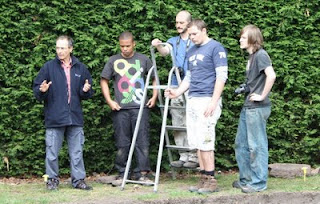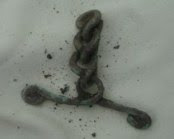Through stained glass...

Emily updates us on yesterday's progress - Today we started our day with planning - not world domination, but in our trench - the large bit between the two field drains, which includes a lot of building debris. Although it sounds a bit dull, drawing what is on the surface onto a grid, it can also be challenging and gives a really close insight into the archaeology and allows one to pick up details and features which one wouldn’t see at first. For instance, we found two as yet unidentified metal objects and could make out changes in the soil, which gave evidence of the structure of our mystery building. Meanwhile, at the north egde of the trench, excavators revealed a long ditch aligned with large stone slabs, the function and significance of which is unclear, but that is the charm of archaeology - you don’t really know what you’re dealing with and when you finally start to figure it out, something new comes up and changes everything. We continued our day with excavating and focusi...




